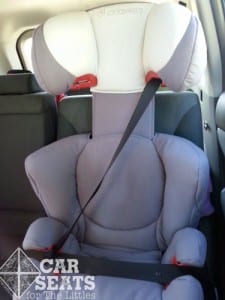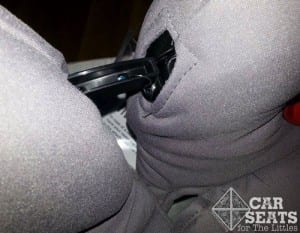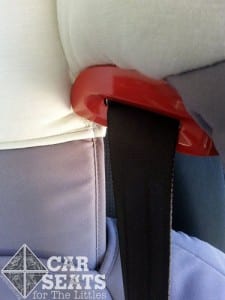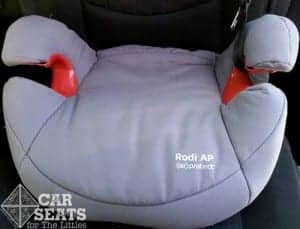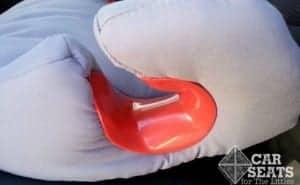Though booster seats don’t have as many moving parts as a harnessed car seat, there’s a large range of features and fit on the market. Choosing the right one can be a real challenge! For my booster rider, we need a booster that’s fairly padded and has a high top shoulder belt guide position since my kiddo is fairly tall and quite slim.
The Maxi-Cosi RodiAP is a mid-priced booster seat with a lot to offer. Though it shares part of a name with the RodiFix, it’s got a number of differences that have quickly made the RodiAP one of my favorite boosters!
CSFTL Quick Stats
- High back booster weight range: 30-120 lbs.
- High back booster height range: 34-57″
- Backless booster weight range: 30-120 lbs.
- Backless booster height range: 34-57″
- Highest belt guide position: 21.5″
- Expiration: 6 years
Features
- Hooks to keep the high-backed portion connected to the backless portion of the booster
- Lightweight, easy to move between vehicles
- 2014 IIHS Best Bet in high-back mode
High Back Booster Mode
Assembly
The box for the RodiAP is quite a bit smaller than the RodiFix’s box. This is because the RodiAP converts to a backless booster in addition to being a high-back booster, where the RodiFix does not.
Assembling the RodiAP was fairly painless — I had to tilt the high-back portion down below being level with the openings on the backless portion, line up the hooks, then just sit the headrest upright and it all clicked into place. This is easier than it sounds, I promise!
Those Hooks!
Sometimes, the smallest things are the biggest things. The RodiAP has an ingenious set of hooks to keep the high-back portion connected to the backless portion. If you’ve ever attempted to carry almost any other kind of high-back booster around, you’ll know how helpful this feature is! No more thinking that the seat is fully assembled, only to have the bottom come loose and start flopping around or worse, fall off, while you’re taking it to the car.
For this feature alone, the RodiAP is one of my new best friends.
Thanks to these little hooks, I can carry the RodiAP around with one hand — the seat is very lightweight and it’s small footprint makes it easy to maneuver into and out of the car. I was able to get the RodiAP into and out of my car’s third row through the hatch without the seat coming apart or banging around because it was too bulky.
Fit to Child: High Back Mode
8 Years Old
The RodiAP has a weight range of 30-100 pounds and height range of 34-57 inches tall, and AT LEAST 4 years old. Regular readers of CSFTL probably know that we don’t recommend a booster until the child is at least 5 years old; here’s more information about booster readiness.
My booster rider is 8 years old, she’s 50 pounds and stands 49 inches tall. She’s also quite slim and this has made finding a booster that fits her well, while being padded enough for her needs quite a challenge. The RodiAP features a fairly plush cover that was an instant hit with my kiddo. This is no small feat!
The RodiAP fits my slender child very well. It would likely fit slender to medium-sized children well. Though it is rated to 120 pounds, a child that size would be unlikely to fit in the RodiAP.
6 Years Old
The RodiAP provides our tiny 6 year old model with a good belt fit as well. The lap portion of the belt is a little high, but it’s across her hips rather than over her belly so it’s not a concern.
Belt Guide Access and Retraction
The shoulder belt guide is fairly easy to access and threading the belt through was pretty easy. The belt didn’t catch on any parts of the seat shell and it’s stayed in place. The belt retracts without issue in my Mazda 5’s second row.
Because the belt guide is closed, once the seat belt is threaded through the guide, it’s kind of tricky to get it back out. The upside to this? It’s very unlikely that the belt will just slide out of place when you don’t want it to.
We’ve tried a number of different boosters and combination seats that convert to boosters over the years. I was pleased to see that the RodiAP’s belt guide is among the easiest to use from our family’s sample data.
The top shoulder height on the RodiAP is an impressive 21.5 inches, making it one of the taller (and therefore, longer-lasting) dedicated boosters on the market. For our family, this means that my booster rider can ride comfortably in a high-back booster for a while yet.
AirProtect
The RodiAP includes AirProtect Side Impact Protection in the headrest. The manual states that the “midpoint of the child’s head should be in the center of the headrest.” This aligns the AirProtect with the correct location on the child’s head. We struggled a bit with this requirement — moving the headrest up that high also moved up the shoulder belt to a place where it didn’t fit quite as close to my daughter’s shoulder as I would’ve liked but it still offered a good belt fit.
Cupholder
The RodiAP includes a detachable cupholder. It’s sort of giant in comparison to the sleekness of the seat itself. It’s not actually in the shape of a cup so it’s not well-suited to carrying the sorts of objects that often make their way into our cupholders. My kids are more fond of bringing craft items, acorns, pieces of halloween costumes, and random bits of paper in their cupholders than they are beverages so for us, the cupholder was kind of a bust.
I suspect that for families who actually carry drink-shaped objects in the cupholders, this one would work just fine.
Backless Mode
Converting to Backless Mode
The manual instructs to lay the high-back portion of the seat on a table, then flip the bottom portion over the edge. This will release the hooks and allow the back to be removed. This process was pretty simple — it took a little more force to separate the pieces than on other high-back boosters but that’s a fair trade for the convenience that those hooks connecting the pieces offers.
The belt guides on the lap portion of the seat are generously sized and allow the belt to pass through easily. The edges of the RodiAP’s seat pan are curved up. This provides a little extra support for my child’s legs — she found this quite comfortable.
Portability
One key feature of backless boosters for us is portability. If my booster rider needs to hitch a ride after school, we send a backless booster with her. The RodiAP is lightweight enough that she could carry it around but the shape of the seat makes it a little less suited for this part of the job. For this purpose, she prefers a booster with more defined armrests — those are easier to carry around.
Fit to Child: Backless Mode
Statistically, children can be just as safe in a backless booster as they are in a high-back booster, provided that they sit properly for the entire ride and have a good belt fit.
In this case, the RodiAP places the lap portion across the top of my model’s thighs and the shoulder belt across the midpoint of her shoulder. As this seat does not come with a seat belt adjuster strap for use with the backless booster, the IIHS gave it a Check Fit rating. In high-back mode it was given a Best Bet.
While the belt fit is just fine for her in both backless and high-back mode, for this child, she tends to stay in the right position more consistently when she has a little extra support around her head and back.
Thoughts From A Booster Rider
My child finds the RodiAP quite comfortable. In my Mazda 5’s second row, she struggled a bit to get it buckled. Since the RodiAP doesn’t have LATCH or ISOFIX connectors to keep it affixed to the seat, it slides around as she’s getting settled. She had to scoot the seat away from the buckle a bit in order to get herself secured. Once she was settled, she found the seat quite comfortable in both modes.
We’ve also tried the RodiAP in our other car, a 2014 Prius V. The backseat in that car is a bench seat with a slightly different seat belt geometry than I have in my Mazda 5. This setup made it easier for her to get buckled so from a convenience standpoint, the RodiAP works better in that car for us.
Pros
- High max shoulder height
- Lightweight
- Hooks that connect the back to the bottom and small footprint make it easy to move between cars
Cons
- Price
- Cupholder is rather unwieldy
- Cover can only be hand washed
Overall Thoughts
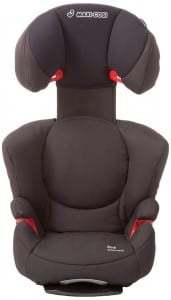
There are a few key features that make the RodiAP a big hit for my family. The high 21.5″ max shoulder height, the ingenious hooks keeping the seat together when I’m moving it around, and the solid belt fit in both high-back and backless modes. The main drawback is merely that it’s a little tough for my kiddo to carry around as a carpool booster and the cupholder didn’t really work for us. Given everything else that is good about this seat, I am pleased to say that the RodiAP is a winner!
Maxi-Cosi was kind enough to provide the booster in this review and they’ve partnered with us to give one away to a lucky winner! Enter below for your chance to win!
*As always, our opinions are our own.*

